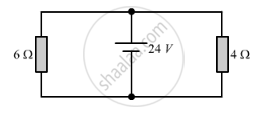Advertisements
Advertisements
प्रश्न
In parallel combination of resistances ______.
पर्याय
p.d. is same across each resistance
total resistance is increased
current is same in each resistance
all of the above are true
उत्तर
In parallel combination of resistances p.d. is same across each resistance.
Explanation:
In parallel combination, the ends of each resistor are connected to the ends of the same source of potential. Thus, the potential difference across each resistance is same and is equal to the potential difference across the terminals of the source (or battery).
APPEARS IN
संबंधित प्रश्न
With a neat labelled diagram and derive the equation for three resistances connected in parallel.
A wire that has resistance R is cut into two equal pieces. The two parts are joined in parallel. What is the resistance of the combination?
Find the current in each resistor in the circuit shown below:

Are the lights in your house wired in series?
If current flows through two lamps arranged:
(a) in series,
(b) in parallel,
and the filament of one lamps breaks, what happens to the other lamp? Explain your answer.
State how are the two resistors joined with a battery when potential difference is same across each resistor.
A combination consists of three resistors in series. Four similar sets are connected in parallel. If the resistance of each resistor is 2 ohm, find the resistance of the combination.
What is the equivalent resistance of 5 equal resistors, each of value 2`Omega` 1 when oonnected in (a) Series ( b) ParaIleI?
A given wire is stretched to double its length. How will its resistance change?
Four resistors each of resistance 5 Ω are connected in parallel. What is the effective resistance?
